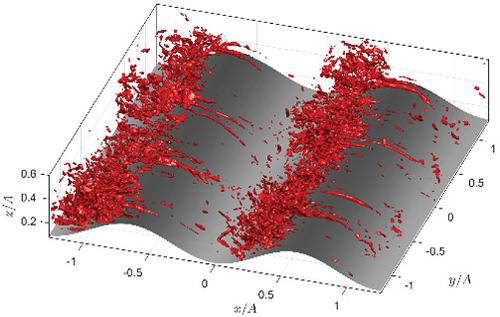当前位置:
X-MOL 学术
›
Earth Surf.Process. Land.
›
论文详情
Our official English website, www.x-mol.net, welcomes your feedback! (Note: you will need to create a separate account there.)
Large Eddy Simulation of three-dimensional flow structures over wave-generated ripples
Earth Surface Processes and Landforms ( IF 3.3 ) Pub Date : 2021-03-27 , DOI: 10.1002/esp.5120 Chuang Jin 1, 2 , Giovanni Coco 2 , Rafael O. Tinoco 3 , Pallav Ranjan 3 , Jorge San Juan 3 , Som Dutta 4 , Heide Friedrich 5 , Zheng Gong 6
Earth Surface Processes and Landforms ( IF 3.3 ) Pub Date : 2021-03-27 , DOI: 10.1002/esp.5120 Chuang Jin 1, 2 , Giovanni Coco 2 , Rafael O. Tinoco 3 , Pallav Ranjan 3 , Jorge San Juan 3 , Som Dutta 4 , Heide Friedrich 5 , Zheng Gong 6
Affiliation

|
We performed a three-dimensional high-resolution Large Eddy Simulation using a sinusoidal ripple-like bedform geometry with spacing and amplitude consistent with equilibrium conditions under the prescribed oscillatory forcing. The simulation results are validated qualitatively and quantitatively with previous laboratory experiments and numerical simulations. Our numerical simulations allow to analyze the presence of “ribs”, strong flow rotational features in the spanwise direction developing perpendicular to the ripple crest. We show that ribs tend to appear on the upslope and crest of ripples and display a dominant spacing, ranging from 0.5λ to λ, during wave phases associated to flow acceleration. When the vortex is transported over the downstream ripple during the flow deceleration, ribs appear for the second time over the upslope of the downstream ripple, with the dominant spacing about 1/8 ripple wavelength. The presence of flow three-dimensionality corresponds to a large variability of the shear stress over ripples in the spanwise direction, which could ultimately favor the development of three-dimensional geometry. The three-dimensional vortex dynamics are evaluated using the concept of vortex strength. Peak vortex strength is observed at the maximum free stream velocity, but the largest variation of the vortex strength and vortex size in the spanwise direction occurs prior to the flow reversal. The variability of the vortex structures might provide a favorable setting for the development of ribs and might relate to the spacing of ribs.
中文翻译:

波浪产生波纹上三维流动结构的大涡模拟
我们使用正弦波纹状床形几何结构进行了三维高分辨率大涡模拟,其间距和振幅与规定振荡强迫下的平衡条件一致。模拟结果与先前的实验室实验和数值模拟进行了定性和定量验证。我们的数值模拟允许分析“肋”的存在,在垂直于波纹波峰发展的展向方向上的强流动旋转特征。我们表明,在与流动加速相关的波相期间,肋骨往往出现在波纹的上坡和波峰上,并显示出占主导地位的间距,范围从 0.5λ 到 λ。当涡流在流动减速过程中通过下游波纹时,肋条第二次出现在下游波纹的上坡处,主要间距约为 1/8 波纹波长。流动三维度的存在对应于展向方向上波纹上的剪切应力的大可变性,这最终可能有利于三维几何学的发展。使用涡流强度的概念来评估三维涡流动力学。在最大自由流速度下观察到峰值涡流强度,但在展向方向上涡流强度和涡流大小的最大变化发生在流动反转之前。涡旋结构的可变性可能为肋的发育提供了有利的环境,并且可能与肋的间距有关。流动三维度的存在对应于展向方向上波纹上的剪切应力的大可变性,这最终可能有利于三维几何学的发展。使用涡流强度的概念来评估三维涡流动力学。在最大自由流速度下观察到峰值涡流强度,但在展向方向上涡流强度和涡流大小的最大变化发生在流动反转之前。涡旋结构的可变性可能为肋的发育提供了有利的环境,并且可能与肋的间距有关。流动三维度的存在对应于展向方向上波纹上的剪切应力的大可变性,这最终可能有利于三维几何学的发展。使用涡流强度的概念来评估三维涡流动力学。在最大自由流速度下观察到峰值涡流强度,但在展向方向上涡流强度和涡流大小的最大变化发生在流动反转之前。涡旋结构的可变性可能为肋的发育提供了有利的环境,并且可能与肋的间距有关。使用涡流强度的概念来评估三维涡流动力学。在最大自由流速度下观察到峰值涡流强度,但在展向方向上涡流强度和涡流大小的最大变化发生在流动反转之前。涡旋结构的可变性可能为肋的发育提供了有利的环境,并且可能与肋的间距有关。使用涡流强度的概念来评估三维涡流动力学。在最大自由流速度下观察到峰值涡流强度,但在展向方向上涡流强度和涡流大小的最大变化发生在流动反转之前。涡旋结构的可变性可能为肋的发育提供了有利的环境,并且可能与肋的间距有关。
更新日期:2021-03-27
中文翻译:

波浪产生波纹上三维流动结构的大涡模拟
我们使用正弦波纹状床形几何结构进行了三维高分辨率大涡模拟,其间距和振幅与规定振荡强迫下的平衡条件一致。模拟结果与先前的实验室实验和数值模拟进行了定性和定量验证。我们的数值模拟允许分析“肋”的存在,在垂直于波纹波峰发展的展向方向上的强流动旋转特征。我们表明,在与流动加速相关的波相期间,肋骨往往出现在波纹的上坡和波峰上,并显示出占主导地位的间距,范围从 0.5λ 到 λ。当涡流在流动减速过程中通过下游波纹时,肋条第二次出现在下游波纹的上坡处,主要间距约为 1/8 波纹波长。流动三维度的存在对应于展向方向上波纹上的剪切应力的大可变性,这最终可能有利于三维几何学的发展。使用涡流强度的概念来评估三维涡流动力学。在最大自由流速度下观察到峰值涡流强度,但在展向方向上涡流强度和涡流大小的最大变化发生在流动反转之前。涡旋结构的可变性可能为肋的发育提供了有利的环境,并且可能与肋的间距有关。流动三维度的存在对应于展向方向上波纹上的剪切应力的大可变性,这最终可能有利于三维几何学的发展。使用涡流强度的概念来评估三维涡流动力学。在最大自由流速度下观察到峰值涡流强度,但在展向方向上涡流强度和涡流大小的最大变化发生在流动反转之前。涡旋结构的可变性可能为肋的发育提供了有利的环境,并且可能与肋的间距有关。流动三维度的存在对应于展向方向上波纹上的剪切应力的大可变性,这最终可能有利于三维几何学的发展。使用涡流强度的概念来评估三维涡流动力学。在最大自由流速度下观察到峰值涡流强度,但在展向方向上涡流强度和涡流大小的最大变化发生在流动反转之前。涡旋结构的可变性可能为肋的发育提供了有利的环境,并且可能与肋的间距有关。使用涡流强度的概念来评估三维涡流动力学。在最大自由流速度下观察到峰值涡流强度,但在展向方向上涡流强度和涡流大小的最大变化发生在流动反转之前。涡旋结构的可变性可能为肋的发育提供了有利的环境,并且可能与肋的间距有关。使用涡流强度的概念来评估三维涡流动力学。在最大自由流速度下观察到峰值涡流强度,但在展向方向上涡流强度和涡流大小的最大变化发生在流动反转之前。涡旋结构的可变性可能为肋的发育提供了有利的环境,并且可能与肋的间距有关。

























 京公网安备 11010802027423号
京公网安备 11010802027423号